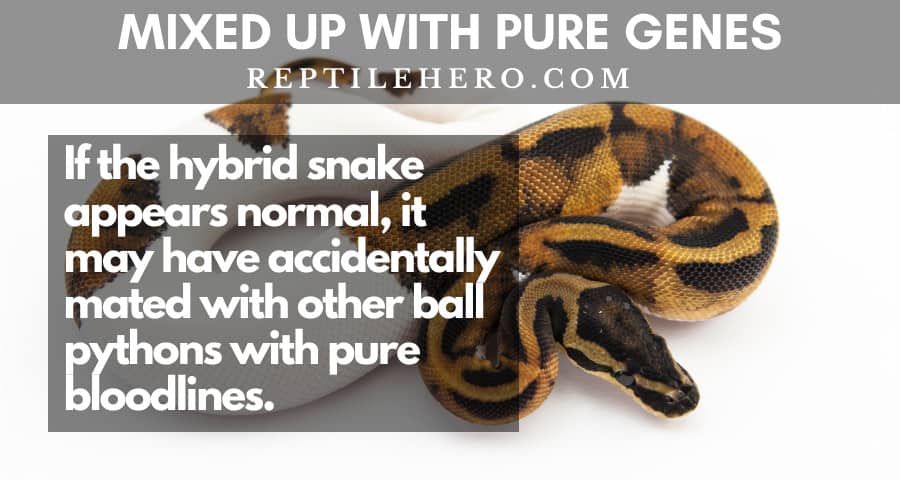Can Ball Pythons Cross-Breed With Other Snakes? (7 Species)
It is tempting for us to think that all snakes could mate with each other as they might all look the same having elongated bodies, flicking tongues, and what have you. Well, that’s not the case. So before trying to get your ball pythons to breed with other snake species, check this article out!
Generally, ball pythons can breed with other snakes belonging to the Pythonidae family. The snake species that have successfully interbred with a ball python include the 1) carpet python, 2) blood python, 3) Burmese python, 4) Angolan python, 5) Woma python, 6) reticulated python, and 7) Sumatran short-tailed python.
What snake breeds can you hybridize with ball pythons? Can anything bad happen by doing this? Continue reading to find out!
Cross-Breeding Ball Pythons With Carpet Pythons
Carpet pythons can be crossbred with ball pythons and may produce a hybrid snake commonly called “Carpalls.” The resulting patterns and coloration visible in this hybrid snake depends on the parents’ morphs. Carpall hybrids are thought to be more terrestrial since one of their parents is semi-arboreal and the other lives on the ground.
Carpet pythons (Morelia spilota) are generally found in Australia and can also be found in Indonesia and Papua New Guinea [1, 2]. This constrictor has seven recognized subspecies including, but not limited to jungle, diamond, and Murray-Darling carpet pythons [3].
Mating a ball python with a carpet python has been done many times, and their offspring are often referred to as ‘Carpal,’ ‘Carpball,’ or ‘Carpall.’ But, the two species can’t cross paths naturally as ball pythons originally come from Africa.
Cross-Breeding Ball Pythons With Blood Pythons
The hybrid offspring of a ball python and blood python pairing, called “superball,” are usually relaxed and not head shy. An adult superball hybrid appears to have the same thickness but a relatively longer body compared to a blood python.
The Python brongersmai is also known as red blood python, Malaysian blood python, Sumatran blood python, or simply blood python. It can be found in the Malay Peninsula, Sumatra, and nearby smaller islands [4].
Blood pythons come from being aggressive, wild-caught snakes into more docile pets due to continuous captive breeding and development. ‘Superball’ is the name given to the hybrid snakes produced from ball python and blood python pairing.
According to my friends who own blood pythons, these thick-bodied snakes are relatively docile after laying their eggs, unlike other constrictors such as ball pythons, which typically take a defensive stance when approached.
Cross-breeding Ball Pythons With Burmese Pythons
According to one pioneer snake breeder, Burmball hybrids could grow up to 8ft. This hybrid results from cross-breeding ball pythons with Burmese pythons. In addition, this hybrid can produce viable offspring.
The Burmese python is one of the gigantic species of snakes and can be found in many parts of Southeast Asia, such as Cambodia, Vietnam, and Thailand [5].
Letting a ball python and a Burmese python mate is possible—and it has already been done. The Burmese python and ball python cross-breeding can produce hybrid snakes known as ‘Burmball.’
The exact lifespan of a Burmball is yet to be determined due to the snake’s continuous development. Moreover, the shyness of the ball python and the calmness of the Burmese python could be present in the Burmball hybrid.
Cross-Breeding Ball Pythons With Angolan Pythons
The angryball python is the hybrid snake from an Angolan and ball python breeding pair. Hybrid hatchlings have a thicker body compared to regular ball pythons.
The Python anchietae, also called escarpment python, Anchieta’s dwarf python, or Angolan python, is native to Namibia and Angola [6, 7, 8]. It is believed that Angolan pythons are the snake species that are most closely related to ball pythons.
Angolan pythons are one of the rarest African pythons in captivity. However, the python’s availability has improved over the recent years due to thorough captive care and breeding.
Now, hybrids between Angolan and ball pythons are up for grabs — they are known as ‘angryball pythons.’
Cross-Breeding Ball Pythons With Woma Pythons
Woma pythons can be cross-bred with ball pythons to produce hybrid snakes called “wall pythons.” The hybrid hatchlings appear to be mild-mannered similar to a regular Woma python.
The Aspidites ramsayi, more commonly known as sand python, Ramsay’s python, or Woma python, is primarily found in Central and Southwestern Australia [9,10]. This mild-mannered python can be found in arid locations such as deserts, shrublands, and savannas with predominantly sandy soil.
However, hybrids’ welfare might be compromised as the parents differ greatly in humidity requirements. Thus, temperature and other care requirements for the Wall python hybrid might need guesswork.
Cross-Breeding Ball Pythons With Reticulated Pythons
Hybrids of reticulated and ball pythons are known as “Baltic pythons.” When compared to a pure ball python hatchling, these hybrids have a slimmer physique.
The reticulated python is one of the giant-sized snake species in the world, along with the green anaconda [11]. Reticulated pythons are widely spread across Southeast Asia and nearly the entire Indonesian archipelago [12]. ‘Reticulated’ is the common name given to this enormous snake due to its net-like, geometric patterns on the body.
Although it doesn’t seem like reticulated and ball python hybridization will happen due to their huge size difference, it has been achieved.
Cross-Breeding Ball Pythons With Sumatran Short-Tailed Pythons
Sumatran short-tailed and ball python hybrids appear to be very chunky and heavy. These hybrids are often observed to have a considerably calm temperament. Moreover, they are known to not be very active snakes.
The Sumatran black blood python, more commonly known as Sumatran black blood python or Sumatran short-tailed python, is native to Sumatra, hence the name. But can also be found in Thailand, West Malaysia, Singapore, and Vietnam [13].
Due to their similar markings, this heavy-bodied snake is often mistaken for other closely related species, the Borneo short-tailed python and blood python.
A hybrid snake bred from a Sumatran short-tailed and a ball python is uncommon in the reptile keeping community due to the popularity of its closely related species, the blood python.
Can you create ball python hybrids?
It is possible to create ball python hybrids. Cross-breeding between hybrids and pure-breed snakes has been done by many expert breeders in the snake-keeping hobby. However, the hybridization of snakes and the breeding of hybrids is a very controversial topic and often frowned upon by many breeders.
Hybridization of Ball Pythons (2 Possible Problems)
What could possibly go wrong when cross-breeding ball pythons and other snake species? Read on to find out!
Uncertain Results
Hybrids may suffer from being sterile and may display abnormal behavior from having parents of different species. The keeper is also likely to experience great difficulty in determining and meeting the exact husbandry requirements for the hybrid snakes.

- Reproductive Issues
A hybrid snake may become sterile, meaning it cannot produce viable offspring or end up only producing infertile eggs.
>> Learn more about infertile eggs in our article on geckos laying infertile eggs.
- Confusing Behavior
If the hybrid snake’s parents are distinctly different from each other—with one being really aggressive and the other being calmer and more docile—you may not know what the mixed-breed serpent will behave like as its parents have contrasting traits.
- Husbandry Issues
In addition, it will be hard to identify how exactly you would care for your hybrid snake if its parents came from a humid place and the other one lives in an arid location.
You may have to guess the temperature, humidity, substrate, and other husbandry requirements that the hybrid snake needs to survive.
Mixing of Gene Pools
Hybrid ball python genes could mix up the pure bloodlines if their records get lost. This may potentially result in all snakes being hybrids and conserving pure bloodlines becoming a problem.

When working with hybrid snakes, you must carefully keep track of the percentage of recessive morphs (pattern and coloration) and the proportions of the reptile’s parental DNA.
It only takes a pair of hands that could lose the snake’s record. When that keeper decided to sell the hybrid snake without being aware of such vital information, it could potentially pollute not only the pure gene pool of ball pythons but also the other snake species.
Hybrid snakes are fantastic to own as pets, but several potential issues come with their misrepresentation. More specifically, breeding misrepresented hybrids could pollute pure bloodlines.
Further Questions
Can you breed ball python siblings?
Breeding ball python siblings can be done, and it is called line breeding. However, unwanted mutations in ball pythons may be produced due to continuous line breeding. To avoid this from happening, experts advise introducing unrelated snakes every few generations of line breeding, a practice called outcrossing.
Can you breed different types of ball pythons?
All ball pythons can be cross-bred with each other. These snakes are all under the same species, Python regius. Each ball python’s distinction is based only on its appearance or coloration, also called morphs.
Can a ball python and a corn snake breed with each other?
Widely separated species cannot easily breed with each other. Corn snakes are colubrids, a distinctively different family from Boidae and Pythonidae (boas and pythons respectively). As a result, the mating of a ball python and a corn snake is impossible, nor will it be successful.
Summary of Cross-Breeding of Ball Pythons
The cross-breeding of ball pythons with other snakes is possible if both reptiles are closely related or are of the same species. A hybrid snake’s appearance, behavior, husbandry, etc., depends on its parental genetic makeup.
Unfortunately, the overall well-being of hybrid ball pythons may be compromised if both parents require greatly different husbandry needs. Hybrids could also pose a threat to conserving pure bloodline species.
Sources
[1]
[2]
https://animalia.bio/carpet-python
[3]
https://www.itis.gov/servlet/SingleRpt/SingleRpt?search_topic=TSN&search_value=634780#null
[4]
https://animalia.bio/python-brongersmai
[5]
[6]
https://www.itis.gov/servlet/SingleRpt/SingleRpt?search_topic=TSN&search_value=634782#null
[7]
https://www.iucnredlist.org/species/177539/7452448
[8]
https://animalia.bio/python-anchietae
[9]
https://www.australiazoo.com.au/wildlife/our-animals/woma-python/
[10]
https://animalia.bio/woma-python
[11]
https://zooatlanta.org/animal/reticulated-python/
[12]
[13]







